The Pioneer SX-3600 receiver, introduced in 1980, represents a fascinating era in audio technology, skillfully blending digital and analog design elements. Positioned as a mid-range offering within Pioneer’s extensive lineup, this receiver retailed at an accessible price of $275 while still delivering a solid 30 watts per channel. A significant portion of the Pioneer SX-3600 production took place in Korea, highlighting global manufacturing trends of the time.
To put the SX-3600 into perspective within Pioneer’s offerings, consider these models from the same series:
- SX-3900: $800, 120 watts per channel (wpc)
- SX-3800: $500, 60 wpc
- SX-3700: $375, 45 wpc
- SX-3600: $275, 30 wpc
- SX-3500: $225, 20 wpc
- SX-3400: $174, 15 wpc
This pricing and power output structure clearly positions the Pioneer SX-3600 as a versatile and budget-conscious choice for audiophiles of the era.
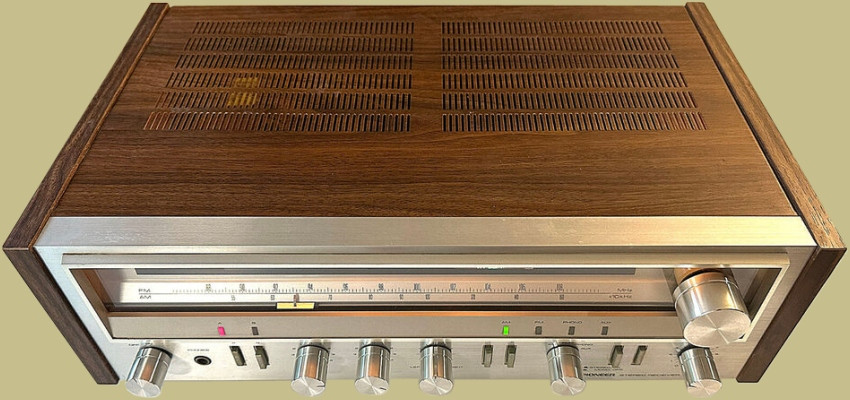 Front view of Pioneer SX-3600 cabinet showcasing its vintage design
Front view of Pioneer SX-3600 cabinet showcasing its vintage design
The Streamlined Front Panel of the Pioneer SX-3600
The front panel of the Pioneer SX-3600 receiver embodies a clean and uncluttered aesthetic, reflecting Pioneer’s design philosophy of minimalism and simplicity during that period, which they termed “Smart Styling.” The SX-3600 was also designed with an eye-catching “walnut-like” metal top and side panels finished in walnut-grained vinyl, adding a touch of classic warmth to its appearance.
Dominating the front panel is a wide, tilted-back analog tuning dial, designed for easy readability of FM and AM station frequencies. The tuning knob itself is generously sized and operates with a smooth, precise feel. All control buttons and knobs on the SX-3600 are constructed with a robust, high-quality feel, indicative of the receiver’s overall build.
Located centrally on a slightly slanted panel, just above the speaker selector and source selection controls, are six LED function indicators. These illuminate to indicate the selected function: Speaker A/B, AM, FM, PHONO, and AUX, providing clear visual feedback to the user.
For users with multiple tape decks, the SX-3600 includes tape monitor switches, accompanied by input/output terminals on the back panel. These switches enable recording and playback capabilities for up to two stereo tape decks. Furthermore, dubbing between decks is possible by connecting one deck to the AUX inputs and recording to the other, enhancing the receiver’s versatility in a tape-centric era.
Additional control features on the Pioneer SX-3600 front panel include:
- Loudness and Balance knobs, the latter featuring a center click for easy neutral setting.
- Mode switch for Stereo/Mono operation.
- A dedicated Stereo FM indicator light.
- Speaker selection for System A, B, or both, with red indicator lights to show active speaker systems.
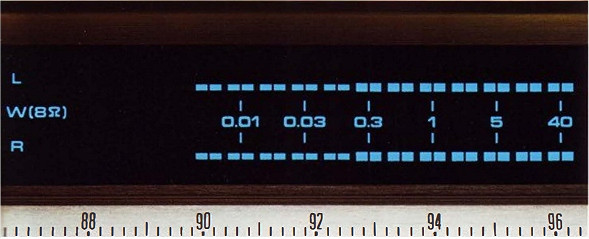 Pioneer SX-3600 Fluroscan meter displaying power output levels with blue illumination
Pioneer SX-3600 Fluroscan meter displaying power output levels with blue illumination
The Unique Fluroscan Meter of the SX-3600
A standout feature of the Pioneer SX-3600 receiver is its innovative “Fluroscan” power output meter. This meter provides a precise visual representation of the amplifier power being delivered to the speakers in real-time. This functionality is not just for show; it serves a practical purpose by aiding in optimizing audio performance and preventing potential distortion.
The Fluroscan meter is a vibrant blue bar graph display, boasting 12 individual light segments per channel. This high level of segmentation allows for very accurate power measurements to be displayed. The technology behind this meter relies on specialized integrated circuits (ICs). One IC is dedicated to driving each bar graph scale, while another manages logarithmic compression of the output readings. The result is a power meter that reacts more quickly and offers superior visibility compared to the more common LCD or LED displays found in other receivers of the time.
A key advantage of the Fluroscan Meter is its ability to briefly hold peak power readings before the display recedes. This short “hold time” for maximum readings is crucial as it allows the listener’s eyes to effectively track the dynamic changes in power output that correspond with the nuances of the music being played. In essence, the Fluroscan meter provides both aesthetic appeal and functional utility, offering a visually engaging blue display that enhances control and understanding of the listening experience.
Simple Yet Effective Tone Controls
The Pioneer SX-3600 adopts a straightforward approach to tone control adjustment. Instead of incorporating a separate, complex tone control amplifier stage, it utilizes a simple CR filter circuit. This circuit is cleverly integrated within the negative feedback loop of the power amplifier itself.
This design methodology, known as “Power NFB” (Negative Feedback), empowers users to tailor the tonal balance of the audio output. This adjustment capability is especially useful for compensating for the acoustic characteristics – both positive and negative – introduced by the listening room environment and the speaker setup. For instance, in a room that tends to sound overly “bright” or lacks bass response, the SX-3600’s bass and treble controls can be adjusted to restore a more balanced and neutral tonal character at the listener’s position.
The primary advantage of this simplified tone control design over more conventional and complex circuits is enhanced efficiency and reduced distortion. By keeping the tone circuitry simple and within the power amplifier’s feedback loop, the receiver avoids the need for additional amplifier stages. These extra stages, while common in some designs, can potentially degrade the overall sound quality. This design choice helps the Pioneer SX-3600 maintain a clean and accurate sonic signature, even when adjustments to bass or treble are made to optimize for specific room acoustics.
 Pioneer SX-3600 receiver angled view showing front and side panel details
Pioneer SX-3600 receiver angled view showing front and side panel details
Tuner Section: Precision FM and AM Reception
Pioneer prioritized high-quality components in the tuner section of the SX-3600 to ensure crisp, clear FM reception and excellent stereo separation.
The “front end” of the tuner is equipped with a field-effect transistor (FET) amplifier. This is paired with a mixing transistor that amplifies the incoming signal while simultaneously minimizing distortion. This critical first stage in the FM signal path is essential for achieving good FM performance, enabling the receiver to finely tune and receive even very weak radio stations.
The signal then proceeds through two ceramic filters in the intermediate frequency (IF) section. These filters play a crucial role in removing unwanted noise and interference, allowing only the clean, intended station signal to pass through. Following the filters, a transistor amplifier further strengthens the signal before it reaches the stereo decoding stage.
For precise stereo demodulation, the SX-3600 employs a specialized integrated circuit (IC). This IC is instrumental in providing the SX-3600 with excellent channel separation and stable stereo imaging when extracting the left and right audio signals from FM broadcasts. An additional IC is responsible for pilot signal removal. This process cleans up the final audio output, ensuring a pristine signal path to the speakers.
The careful selection of components within the FM processing path enables the Pioneer SX-3600 receiver to effectively capture even weak radio signals from the airwaves. It then accurately decodes the stereo audio information, resulting in an enjoyable and high-fidelity radio listening experience.
The Tuning/Signal meter on the front panel is a combination instrument, providing accurate indication of the center-channel tuning for FM stations and signal strength readings for both AM and FM bands.
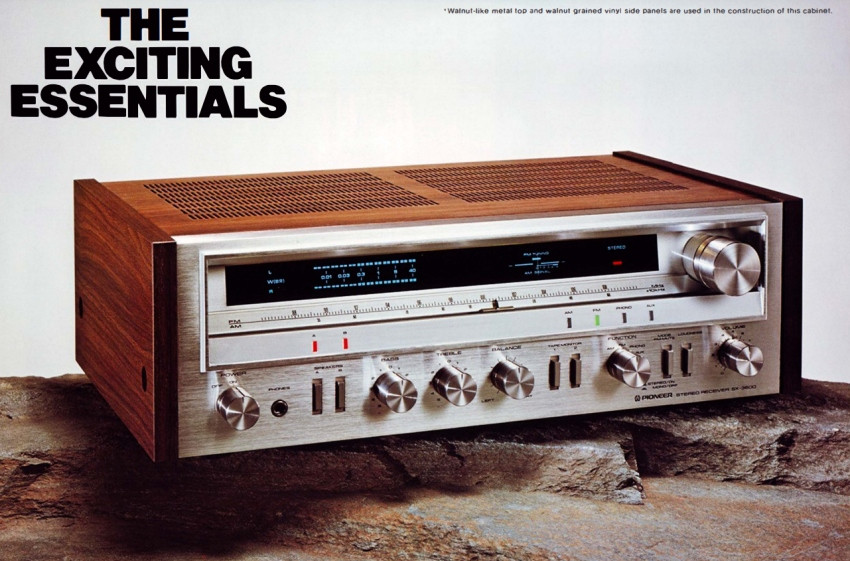 Vintage Pioneer SX-3600 advertisement showcasing its features and design
Vintage Pioneer SX-3600 advertisement showcasing its features and design
Pioneer SX-3600 Specifications
AMPLIFIER SECTION
- Continuous Power Output: 30 watts per channel (wpc) at 8 ohms, 20 Hz to 20,000 Hz
- Total Harmonic Distortion (THD): No more than 0.05% (20Hz to 20,000Hz, 8 ohms, from AUX)
- Intermodulation Distortion (IMD): No more than 0.05% (50Hz: 7,000Hz = 4:1, 8 ohms, from AUX)
- Damping Factor (20 to 20,000Hz, 8 ohms): 35
Input Sensitivity/Impedance:
-
PHONO: 2.5mV/50k ohms
-
AUX: 150mV/50k ohms
-
TAPE PLAY 1: 150mV/50k ohms
-
TAPE PLAY 2: 150mV/50k ohms
-
PHONO Overload Level: 140mV (1kHz, T.H.D. 0.1%)
Output Level:
- TAPE REC 1: 150mV
- TAPE REC 2: 150mV
- SPEAKERS: A, B, A+B
- HEADPHONES: Low impedance
Frequency Response:
- PHONO (RIAA Equalization): 30 to 15,000Hz ±0.3dB
- AUX, TAPE PLAY: 10 to 50,000Hz +0.5dB, -3dB
Tone Control:
- BASS: ± 8dB (100Hz)
- TREBLE: ± 8dB (10kHz)
- Loudness Contour: +6dB (100Hz) (Volume control set at -40dB position)
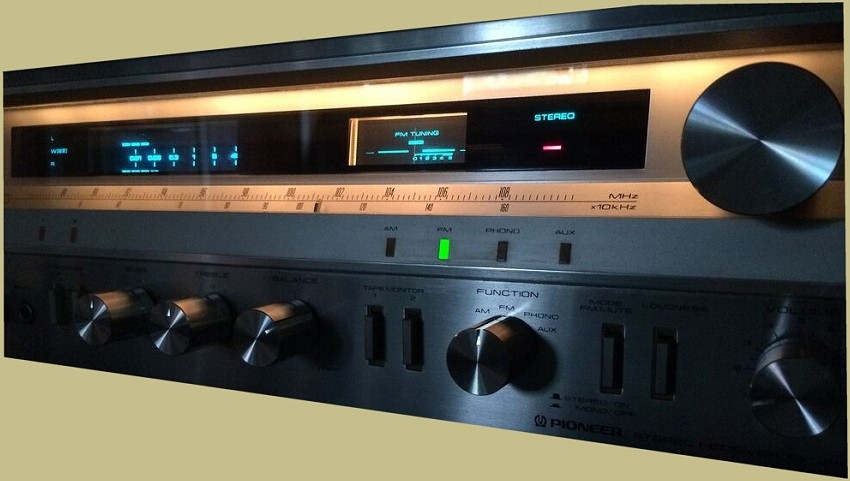 Close-up of Pioneer SX-3600 lamps illuminating the function display and meters
Close-up of Pioneer SX-3600 lamps illuminating the function display and meters
FM TUNER SECTION
- Usable Sensitivity: Mono: 11.2dBf (2.0µV)
- 50dB Quieting Sensitivity:
- Mono: 16.1dBf (3.5µV)
- Stereo: 37.4dBf (39µV)
- Signal-to-Noise Ratio:
- (at 65dBf): Mono: 78dB
- (at 85dBf): Stereo: 72dB
- Distortion (at 65dBf), 1 kHz: 0.1% (mono), 0.15% (stereo)
- Frequency Response: 20 to 15,000Hz +0.5dB, -1.0dB
- Capture Ratio: 1.0dB
- Spurious Response Ratio: 65dB
- Image Response Ratio: 65dB
- IF Response Ratio: 90dB
- AM Suppression Ratio: 55dB
- Muting Threshold: 19.2dBf
- Stereo Separation: 40dB (1kHz), 35dB (30Hz to 15kHz)
- Antenna Input: 300 ohms balanced, 75 ohms unbalanced
GENERAL
- Dimensions: 17 11/16 inches (W) x 5 9/16 inches (H) x 12 1/16 inches (D) (450mm x 142mm x 306mm)
- Weight: 18 lbs 1 oz (8.2 kg)
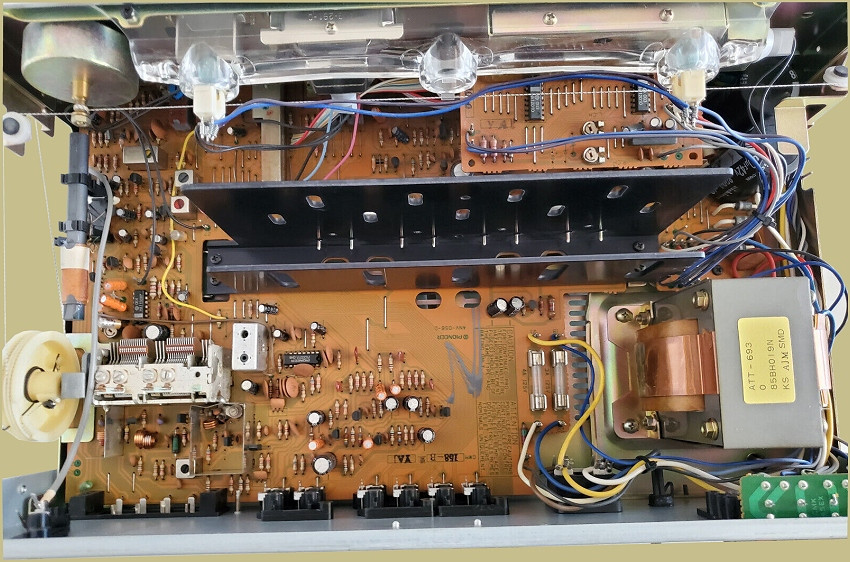 Internal components of Pioneer SX-3600 showcasing amplifier and tuner circuitry
Internal components of Pioneer SX-3600 showcasing amplifier and tuner circuitry
Amplifier Design: Reliable and Robust
The Pioneer SX-3600 incorporates a well-established and dependable internal amplifier design. This design prioritizes delivering a clean 30 watts of power per channel. While perhaps not as extravagant as some higher-end receivers available during the same era, Pioneer opted for this time-tested circuit design. The rationale was to ensure greater long-term reliability and to avoid introducing unwanted frequency effects or added noise that could be associated with more complex or less proven designs.
The amplifier circuit begins with a differential input stage, coupled with a current mirror. This configuration is crucial for accurately translating the incoming audio signal. This stage then hands off to a pre-driver stage that incorporates special “bootstrapping” techniques. Bootstrapping is used to maintain negligible levels of distortion in the pre-driver stage. Finally, the push-pull power amplification section utilizes carefully selected transistors in a balanced configuration. This balanced design is key to achieving excellent separation between the left and right audio channels.
The power supply of the SX-3600 begins with a substantial EI-core transformer. This heavy-duty transformer is matched with large filter capacitors. These components work together to provide a smooth and stable supply of current on demand to the amplifier circuitry. This high-quality power foundation is essential for supplying all internal sections of the receiver properly. It plays a critical role in keeping noise and distortion to a minimum while preserving the full range of musical dynamics and frequency extremes. Consistent stereo separation across the entire audible frequency range is also maintained thanks to this robust power supply design.
The resulting amplifier section of the Pioneer SX-3600 is characterized by very good overall performance and ample power for its intended use, all achieved without unnecessary frills or gimmicks. Pioneer’s design philosophy for this receiver clearly favored proven, high-current designs over incorporating flashy but potentially less reliable features.
One known issue with the SX-3600, common in vintage electronics of this period, is the power regulator transistors. These are known to sometimes develop cold solder joints over time. Years of thermal cycling – the transistors heating up during operation and then cooling down when powered off – can cause the solder to crystallize and weaken. Fortunately, in many cases, a quick resoldering of the relevant board can effectively resolve many operational issues related to this.
 Rear panel inputs and outputs of Pioneer SX-3600 showing connectivity options
Rear panel inputs and outputs of Pioneer SX-3600 showing connectivity options
User Reviews and Feedback
It is a simple but absolutely great sounding receiver that does pack a little punch.
Recap it and let it sing. Gobs of clean power and all discrete (no awful power packs/ICs in power stage). Plus, the fluroscan is awesome and cool. FM tuner incredible.
It sounds better than expected with nice stereo separation & fidelity for such a small receiver.
Rear Panel Connectivity
The back panel of the Pioneer SX-3600 offers a comprehensive set of input and output connections. It includes dedicated inputs for a Phono turntable and an auxiliary (Aux) source, as well as inputs and outputs for two tape decks, labeled Tape 1 and Tape 2. For speaker connectivity, the SX-3600 provides output terminals for two sets of speakers, allowing for speaker system A, speaker system B, or simultaneous operation of both (A+B). Additionally, the rear panel features two AC outlets – one switched and one unswitched – providing convenient power access for ancillary audio equipment.
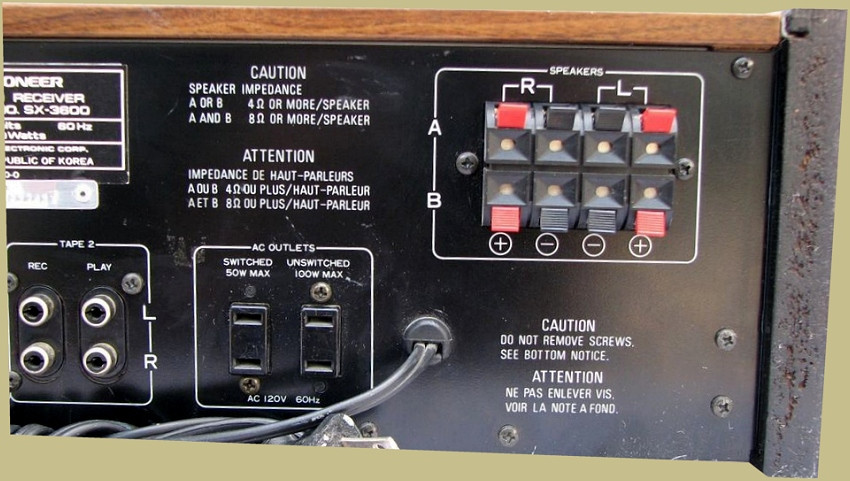 Speaker connection terminals on the back panel of Pioneer SX-3600 receiver
Speaker connection terminals on the back panel of Pioneer SX-3600 receiver
Conclusion: A Stylish and Capable Vintage Receiver
Overall, the Pioneer SX-3600 stands out as a highly recommendable vintage receiver. It was manufactured during a transitional period in audio technology, just before the widespread adoption of fully digital systems. As such, it retains the charm of an analog tuning dial while incorporating modern features like the eye-catching Fluroscan meter and efficient circuit designs. The beautiful blue Fluroscan meter is indeed a significant selling point, adding a distinctive visual element. The SX-3600 provides ample power for use in a moderately sized room or a garage, and it delivers a high level of audio performance when in good working order. Furthermore, its stylish design ensures that the Pioneer SX-3600 would be a visually appealing addition to any vintage audio setup, blending classic aesthetics with solid audio engineering.
Note: Purchasing through eBay links may result in a referral commission.
Loading…
